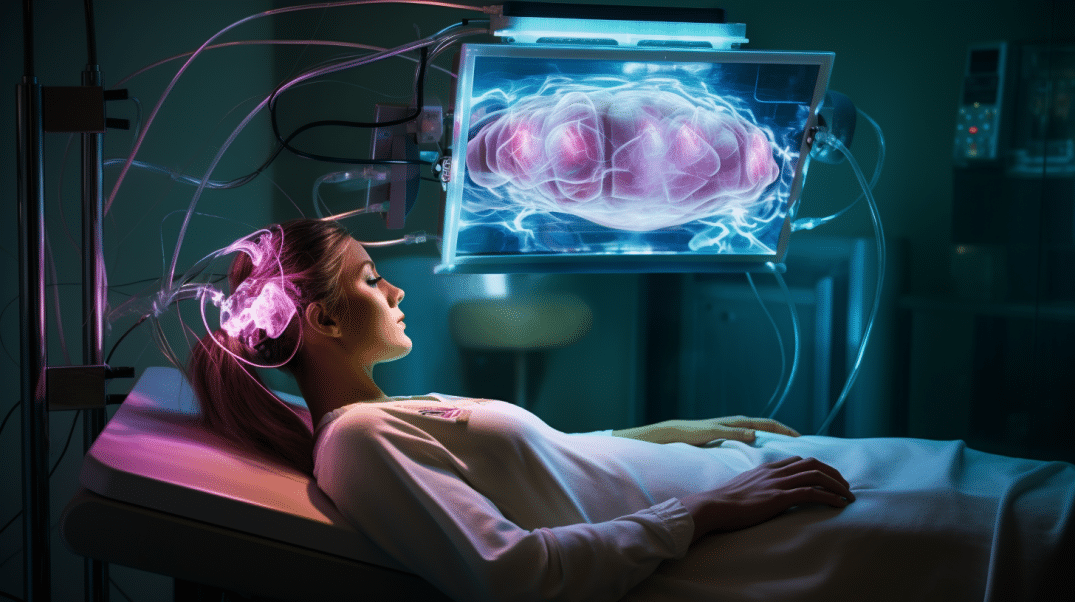Focused ultrasound is emerging as a potentially revolutionary new tool for precisely stimulating the brain without surgery.
This novel approach could transform how we diagnose and treat everything from depression and OCD to Alzheimer’s and stroke.
Key Facts:
- Focused ultrasound uses precise sound waves to stimulate small regions deep in the brain without any incisions.
- It can excite or inhibit neural activity, unlike current methods like TMS or tDCS which can only excite.
- Low intensity focused ultrasound allows mapping neural circuits noninvasively to understand brain disorders.
- High intensity focused ultrasound can ablate diseased brain tissue with no surgery.
- Focused ultrasound may allow targeted delivery of stem cells, antibodies, nanoparticles, and drugs to the brain.
Source: Focus (Am Psychiatr Publ) 2022
Our current toolbox for treating brain and mental health disorders has major limitations.
Focused ultrasound offers a way to precisely stimulate any region of the brain without surgery.
And it can both increase and decrease neural activity, unlike TMS and tDCS which can only excite regions.
This could give clinicians an entirely new noninvasive approach to diagnose and treat everything from mood disorders to Alzheimer’s disease.
How Focused Ultrasound Works
Focused ultrasound utilizes precisely targeted sound waves to stimulate the brain.
An array of transducers directs ultrasound waves to a focal point deep in the brain, like sunlight focused through a magnifying glass.
The waves penetrate the skull and create pressure changes at the target region.
This can mechanically excite or inhibit neural activity.
The ultrasound intensity determines the effect.
Low intensity focused ultrasound subtly modulates neural circuits without damaging tissue.
Higher intensity can ablate tissue through thermal effects similar to laser eye surgery.
This allows noninvasive destruction of diseased areas without surgery.
Applications in Brain Mapping and Neuromodulation

Low intensity focused ultrasound is allowing neuroscientists to map brain circuits related to emotions, cognition, and behaviors.
This is shedding light on the underlying biology of neuropsychiatric disorders.
Researchers can noninvasively stimulate a brain region and observe impacts on thinking and emotions.
This clarifies which areas contribute to conditions like anxiety, OCD, and depression.
Clinicians are also using low intensity focused ultrasound as a novel form of brain stimulation therapy.
Recent studies show it can improve mood in depression by activating key emotion regulation regions like the prefrontal cortex.
Other work indicates focused ultrasound can reduce physical pain by inhibiting activity in pain pathways of the thalamus.
This neuromodulation occurs instantly during treatment and is reversible afterwards.
Because focused ultrasound can stimulate deep brain structures with millimeter precision, it may succeed where current noninvasive neuromodulation techniques fail.
Transcranial magnetic stimulation is limited to superficial cortical regions directly under the skull.
Transcranial direct current stimulation is even less focused.
Deep brain stimulation requires surgical implantation of electrodes in subcortical areas.
Focused ultrasound bridges this gap, allowing targeted stimulation of deeper emotion and reward centers often problematic in mental illness.
This includes limbic regions like the amygdala, hippocampus, nucleus accumbens, and others.
Treatment can also incorporate multiple brain regions in a network-based approach that may better address complex neuropsychiatric diseases.
High Intensity Focused Ultrasound for Ablation
High intensity focused ultrasound has also been used for noninvasive ablation of dysfunctional brain tissue.
This thermal ablation is analogous to laser eye surgery destroying retinal cells.
High intensity focused ultrasound precisely melts away microscopic regions of tissue deep in the brain without any incisions.
This technique is FDA approved to treat medication-resistant essential tremor and tremor-dominant Parkinson’s disease.
Recent research indicates it may also help obsessive-compulsive disorder and major depression by ablating overactive parts of the limbic system.
In one study, bilateral ablation of the anterior limb of the internal capsule markedly reduced OCD symptoms.
Remission lasted over a year for some patients. Similar focused ultrasound capsulotomy studies show promise for depression.
However, these initial psychiatric applications require more research before widespread clinical use given the irreversibility of tissue ablation.
Nonetheless, focused ultrasound capsulotomy could one day replace invasive capsulotomy procedures currently performed on OCD and depression patients.
The incisionless nature substantially reduces risk of hemorrhage and infection.
Targeted Drug Delivery
Another exciting potential application of focused ultrasound is targeted delivery of drugs and other therapeutic agents to the brain.
Focused ultrasound can temporarily open the blood-brain barrier in a localized region.
This allows systemically injected therapies to cross into the brain from the bloodstream only where the barrier is opened.
Researchers have shown focused ultrasound can enhance localized brain uptake of cancer drugs, antibodies, stem cells, nanoparticles, and more.
It may also boost delivery of endogenous immunotherapies and exosomes.
This could enable noninvasive precision targeting of Alzheimer’s drugs to amyloid plaques or neuroinflammation-reducing compounds to specific regions.
Anti-Inflammatory Effects
There is mounting evidence that neuroinflammation contributes to psychiatric illnesses like depression and anxiety.
It also exacerbates brain conditions involving more overt inflammation like stroke, multiple sclerosis, and head trauma.
Remarkably, emerging research indicates focused ultrasound itself has anti-inflammatory effects in the brain.
Studies in animal models show focused ultrasound reduces pro-inflammatory signaling and stimulates anti-inflammatory cytokines in the brain.
This calms the neuroimmune response underlying many brain disorders.
Though not fully understood, the anti-inflammatory benefits likely involve effects of ultrasound on glial cells, vascular permeability, and other factors.
More research is needed, but this represents an entirely new therapeutic mechanism with major implications for treating inflammation-related brain disease.
The Future of Brain Stimulation
Focused ultrasound is poised to fundamentally change how we diagnose, map, and manipulate brain function.
Its unique ability to noninvasively stimulate deep subcortical circuits fills a major gap left by current transcranial neuromodulation techniques and deep brain stimulation.
Thermal ablation of tissue could likewise transform psychiatric surgery.
With further development, focused ultrasound has the potential to become a standard psychiatric treatment.
As a research tool, it is already elucidating neural circuits of mood, anxiety, cognition, and behavior. This will shed light on psychiatric disease biology and help guide more precise treatments.
There are still many open questions regarding safety, dosing, and long-term effects for focused ultrasound.
But the approach represents one of the most significant advances in interventional neuroscience in decades.
Focused ultrasound technology will likely continue rapid development and refinement given the immense clinical need.
Patients with previously untreatable psychiatric illnesses may soon have new hope.
References
- Study: Ultrasound as a neurotherapeutic: a circuit- and system-based interrogation
- Authors: Norman M Spivak B.S. et al. (2022)







